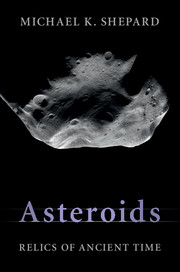Book contents
- Frontmatter
- Dedication
- Contents
- Preface
- Acknowledgements
- Brief list of asteroid and meteorite terms
- 1 It's a small world
- 2 A night at the zoo
- 3 It came from outer space
- 4 A day at the museum
- 5 The gambler's fallacy
- 6 Remembrance of things past
- 7 The ties that bind
- 8 Terra incognita
- 9 To your scattered bodies go
- 10 Scouts, sappers, and miners
- Glossary
- Bibliography
- Index
- References
10 - Scouts, sappers, and miners
Published online by Cambridge University Press: 05 May 2015
- Frontmatter
- Dedication
- Contents
- Preface
- Acknowledgements
- Brief list of asteroid and meteorite terms
- 1 It's a small world
- 2 A night at the zoo
- 3 It came from outer space
- 4 A day at the museum
- 5 The gambler's fallacy
- 6 Remembrance of things past
- 7 The ties that bind
- 8 Terra incognita
- 9 To your scattered bodies go
- 10 Scouts, sappers, and miners
- Glossary
- Bibliography
- Index
- References
Summary
Forewarned is forearmed.
Miguel de Cervantes, Don Quixote
APOPHIS
On an otherwise quiet summer day in June 2004, a trio of astronomers (Roy Tucker, David Tholen, and Fabrizio Bernardi) discovered yet another near-Earth asteroid – an Aten – designated 2004 MN4. Astrometric observations were automatically entered into the Minor Planet Center's database in Cambridge, Massachusetts, which are uploaded daily to the NASA Sentry Program and the European Space Agency's NEODyS risk page. These are automated programs that plow through all asteroid observations, compute orbits, and look for potential collision threats in the future.
For asteroid 2004 MN4, both the Sentry and NEODyS programs flagged an April 13, 2029 close approach. Too close. As observations continued to accumulate throughout the rest of 2004, the probability of impact with the Earth on that date climbed. Two days before Christmas 2004, astronomers at the Jet Propulsion Laboratory estimated the probability of a 2029 impact at nearly 3%. Based on its absolute magnitude, estimates for its size were in the 400 m range. An impact with an asteroid this big would be bad, not extinctionlevel bad, but certainly one of the greater environmental catastrophes to be suffered by civilization in recorded history.
Only four days later, precovery images of 2004 MN4, dating from March 2004, had been found. When incorporated into the orbital calculations, they effectively ruled out an impact in 2029. Arecibo radar observations made in late January 2005 definitively ruled out a collision in 2029, but placed its passage to be within the range of our orbiting geostationary satellites, some 30,000 km above the Earth's surface. The orbit was now known well enough for numbering and naming, and in July 2005, 2004 MN4 became known as 99942 Apophis, named for an early Egyptian god of destruction.
Continued analysis of the orbit showed that there was a slight chance that, during the 2029 encounter, Apophis would be deflected into an orbit that would collide with Earth in 2036, but additional radar observations in January 2013 – this time from Goldstone – definitively ruled this out.
- Type
- Chapter
- Information
- AsteroidsRelics of Ancient Time, pp. 283 - 311Publisher: Cambridge University PressPrint publication year: 2015



